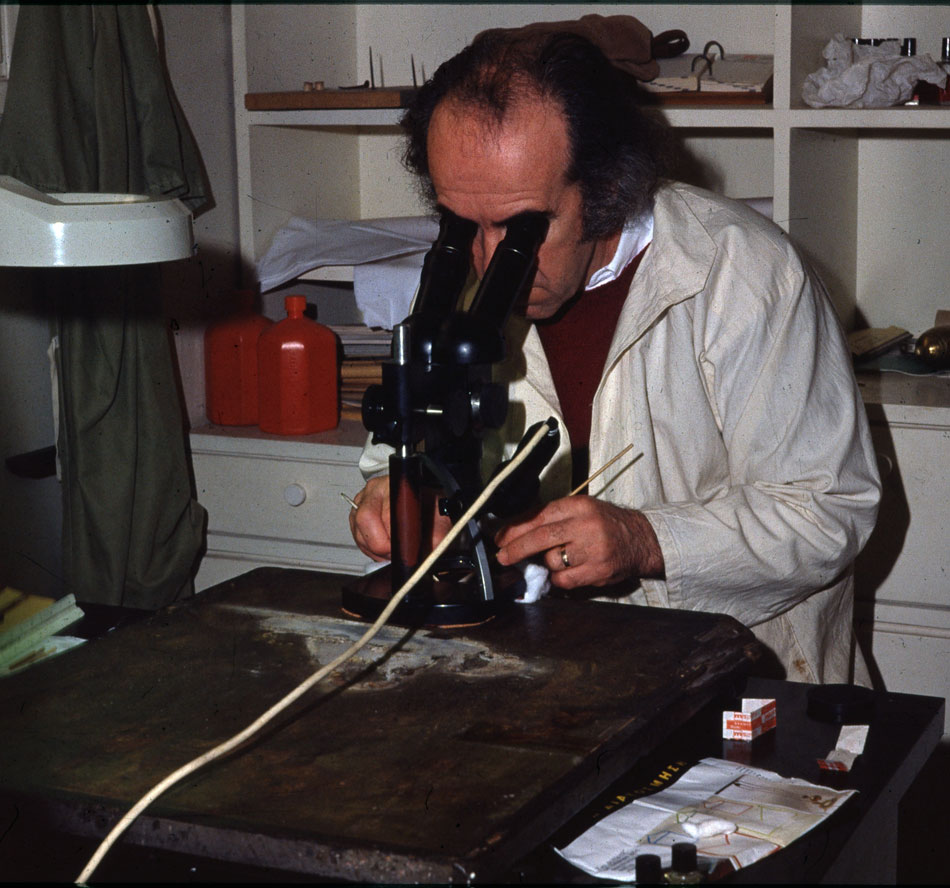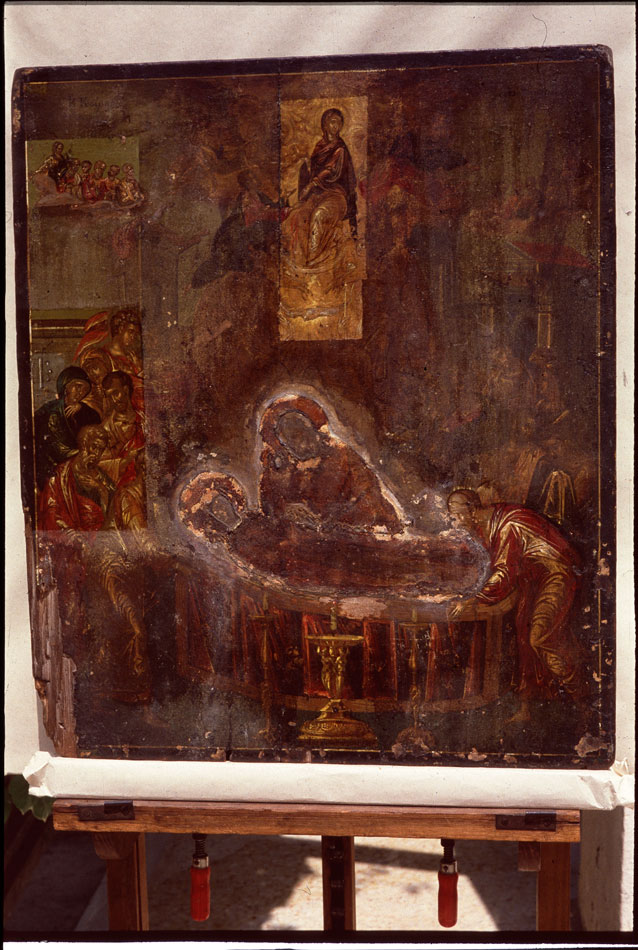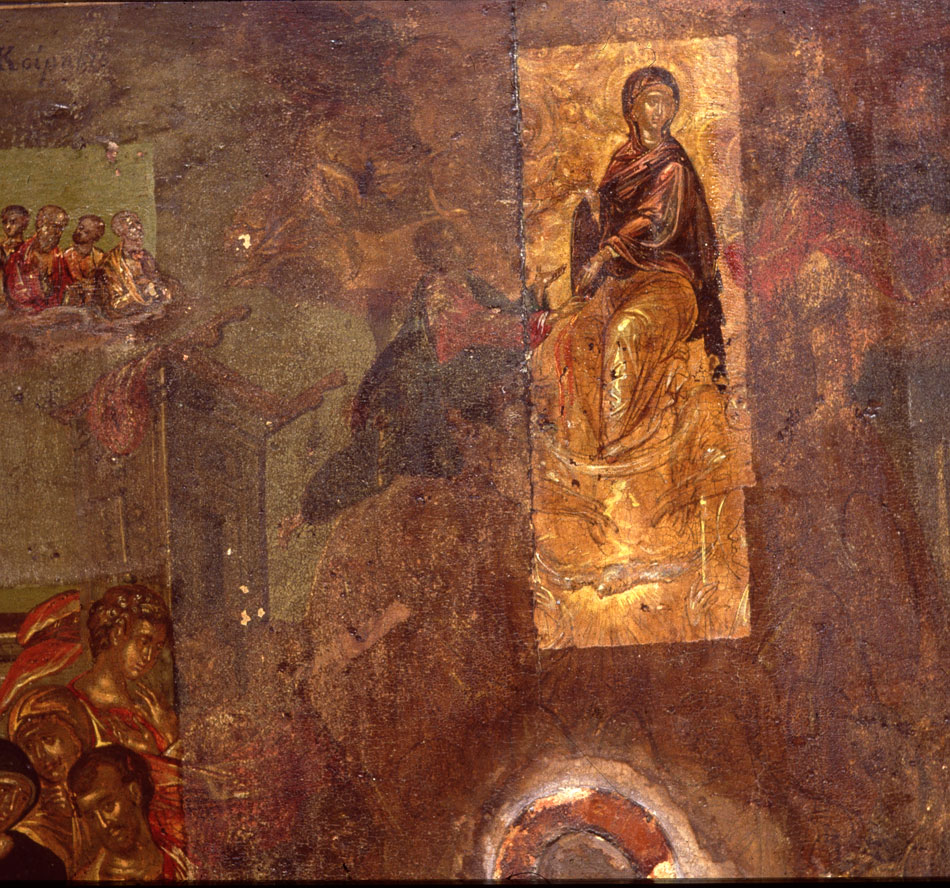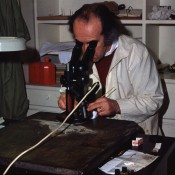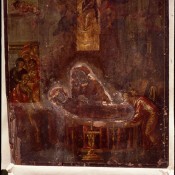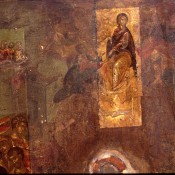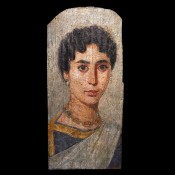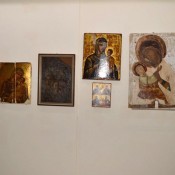For some time now, universities and the field of research have been responsible for the conservation of works of art. The consequences of this are twofold. The first, which is positive, has established conservation as an important factor in the rescue and preservation of man’s cultural heritage and has thus been accepted on a global scale.
The second consequence, however, is negative and has led to a kind of arrogance on the part of the specialists which may, in turn, transfer the passion of the convert to the conservationists. Thus, it became very easy to start using ways and materials dictated by new chemical substances emerging from related industries. This phenomenon created a strong sense of responsibility for us the more senior in this field, rekindling earlier considerations particularly regarding the cleaning of the artefact.
How far can we go in the conservation and restoration of an artefact? And to what degree does the artefact itself allow us to intervene? Undoubtedly, we are the ones entirely responsible for setting the limits.
Considerations on the conservation of paintings
It is true that conservation cannot end with the fixing of pigments or the deterring of the artefact’s future deterioration. The conservator’s dream is restoration at an aesthetic level starting with the painting’s cleaning and ending with his, the conservator’s, personal work on it. This is, moreover, how he established himself as the person holding the magic key to revealing to the art lover or the pilgrim the art work as it originally appeared from the hands of its creator. This type of ambition which always came at some cost to art itself, is what must be controlled and acquire some sense of proportion.
It is true that this craze is a feature of other individuals connected with the art work’s conservation, whether these are archaeologists or other specialists often responsible for putting down guidelines for the work’s restoration. This issue is debatable as long as it starts from those relevant to conservation. When, however, guidance is offered by those lacking experience or, worse, by human factors involved in the trading of works of art, the same issue sometimes becomes dangerous and occasionally even fatal.
Let us, however, take things from the beginning. When talking specifically about paintings, we should first place them where they belong and then move on to coping with them. In Greece in particular, the paintings handled by the conservator are the ones done on canvas, wood or walls and, less often, those done on paper.
The conservation of painting, for several years now, operates within the framework of principles and methods determined by European centres of conservation, who from time to time pass these guidelines to Greek conservators through announcements, publications and workshops.
Concerning this topic, we shall not express our own views as yet, because there is not a long tradition in Greece of painting on canvas. In the case of icons and wall painting, our views should be heard because they are a result of long experience drawn from both the artefacts themselves and from monuments and moreover from our being constantly informed of the latest developments in other countries.
The conservation and restoration of icons
How can conservation be defined and how can we safeguard the restoration of an artefact such as the religious icon? Conservation that concerns the fixing of the work, the deterring of future damage and whatever is determined by rules, can be taught and tackled with recipes. Here, also, there are obviously, many different cases and the conservator is often faced with a unprecedented problem. But, again, this can be treated and his able hands will fix the wood, the colour and the undercoat without any dangers to the work.
The big problem starts with the cleaning of the surface of the painting, the first step and a dangerous one in the work’s restoration. Many questions arise in this case: Who is the painter? Where did he make the painting? What is his technique? What is his style? What colours does he use and how sensitive are they? Are there tricks such as glazes and why has he used them?
It is not hard to guess what is needed at this point. First of all the conservator should be familiar with the period of the work and the school or workshop it belongs to. Next, he should be able to touch the work, following the movement of the artist’s brush strokes, so as to understand the painting’s gradual evolution. He must also locate the binding of the boards on which the work has been painted, down to the nails that have been used. He should likewise be able to trace previous modifications or possible damage caused by these, as well as the extent of damage brought on by the passage of time. The conservator then has to face all sorts of subsequent problems such as searching for possible inscriptions on the work or for the old varnish and whether it has been applied to have some desired colour effect. His main problem, however, is to find whether the work has those famous glazes that are always invisible to those who do not know how to search for them.
The above are a few of the things that the conservator needs to notice, since there are many more that cannot be isolated to create a code for the conservator to refer to when necessary. If, on the other hand, all these things are needed and they don’t happen, how many works must we burn, how many signatures must we look for in vain, how many works will not at all resemble those first made by the painter? Are we then protected by the new materials? Are we helped by drastic solvents? I’m afraid not. Should we therefore ignore our natural curiosity and our passion for the work’s original appearance and not clean it?
Here we reach the crucial moment where we are asked to decisively face the problem. First we have to see what this coloured wood means to us, lying on our bench which can be equipped with a stereomicroscope or some other scientific instruments. Is it so precious to us? How much can we see it that way and how much can we respect it? How important to us is the painter’s glaze that may get lost? How important is an inscription or some element which vanished during conservation?
All these conscience related issues cease to exist when, from the start, the conservator believes in the value of the work he is conserving, which is easy, if he is not only equipped with the knowhow of the latest materials, but mainly with a deep knowledge of the art he is required to restore. Is the road then open to the cleaning of the work? Possibly. We no longer need to fast like the actual painter would do to prepare for the painting of his icon. This was not, however, the only thing done by the poor painter. His preparation began well before putting both his colour and talent in the icon. For a long time he prepares the foundations of his work, the ground work and the gilding, he chooses his technique and he decides on his means of expression. This is the point where we also should stop. Study and constant research are required related to the technique of the work we have to tackle, as well as study and research of the colours that the artist has used, an inquiry into the period and the school to which he belongs ,so as to be ready to see his peculiarities.
Then come documentation, photographing, the study of damage, a tracing of its causes and above all collaboration with other specialists or colleagues. It should especially be said of us Greek conservators who are entrusted with masterpieces of Greek painting and not with an Elizabethan crystal goblet, that we should not be hasty. There should be no hasty and makeshift decisions, no hasty and sloppy training of conservators, no showing off. Just scholarship, work and above all modesty. I cannot start from the great works, my sense of responsibility should not allow me to intervene quickly and unprepared. “But first try out your skill on a small icon” says the old craftsman and “if you are successful with the small one, then attempt the big one. Or else give up so as not to spoil it”.
What are the dangers that we so often encounter when cleaning an icon and how do they relate to its technique and its genre that we insist so much on knowing? Icons arrive at our workshops which are, unfortunately, still not as we would want them to be. They come from museums and monasteries and date from the 12th to the early 19th century. This is a long period of time and it is natural for the technique of egg tempera, most often used by painters, to go through various phases in which new techniques are tried out. Sometimes it is the polishing that changes, other times it is the gilding and usually it is the colours. At times they are valuable and fine grained and other times they are of poorer quality and coarse grained.
Some small examples
On many occasions, different mediums are tried out. In the workshops of Macedonia, starting from the 12th century, silver was used on the background (field), being more sensitive than gold. The silver was then covered with coloured varnish, producing a shining golden effect. This was also done in Russian icons. Its treatment during the removal of the varnish is completely different to that of gold. From the same region come works with backgrounds of ochre, terracotta red or blue, which immediately present the problem as to whether they are the original backgrounds or if they were made at a later date. The colours used by northern Greek workshops are also problematic both in the old works and in those dating from after the Fall of Constantinople. They are coarse grained and crude.
The mediums are different for icons originating from cities that are big and rich. We find shiny well polished gilding on icons that have a definite origin from Constantinople especially those of the 14th century. Here, however, we have more complex colours. We find the shiny, valuable and fine grained colours given second and third coatings which occasionally are a different colour. At this point, things become very dangerous. There are different problems in the 15th century icons of the Early Cretan School where techniques coming from the West are tried out. Transparent washes, sometimes invisible to the naked eye, are more frequent here. These late Gothic sensitive diluted highlights are more easy to startle us by their small resistance to organic solvents.
The “Dormition of the Virgin” by El Greco
The technique of icons from the second half of the 16th century is more complex and all together sensitive. Here, we encounter the mixing of materials, perhaps of oil, influenced by the painting of Venice. One of the most representative examples is that of the “Dormition of the Virgin” by Theotokopoulos/El Greco (fig. 2) which was found in Syros and displayed at the exhibition in the Byzantine and Christian Museum of Athens, celebrating the hundred years of the Christian Archaeological Society. In this case, the colour was left untouched. In my attempt to clean the painting, I restricted myself to removing only one section of the layer of varnish by applying a mechanical method. The rest, having become thinner, acquired some transparency which allowed the viewing of the composition (fig. 3).
The Overpainting of icons and paintings: Stage one
Problems related to the surface cleaning of icons, continue nevertheless. It is a well known fact that the works arriving at our workshops are rarely untouched by more recent modifications. Over painting on painted surfaces darkened by time are among the easiest cases we encounter. Here, however, the conservator needs both an education and training to identify the period and the type of over painting. If it is old, then, again, issues become complicated. We have the right to reject some old intervention, particularly when it is spread over a large area of the work but, if we do remove it, how do we then make the most of it? In similar cases the new painting is placed on a fresh undercoat and the older one is revealed, bearing a few or more signs of damage which had led to its being painted over in the first place. In another case presenting the greatest problem, the old painting bears extensive damage on its surface “healed” with fresh caulking which, in several cases covers the original painting. In this extensive operation the conservator’s initiative is crucial and he must decide to rid the work of all later and usually crude modifications that make the icon or painting aesthetically inferior.
The worst case to be handled by the conservator are already restored works which arrive to him escorted by glowing references of scientific conservation. In fact, it is possible that the work has effectively been destroyed, despite all the previously mentioned research having taken place prior to its conservation. I refer both to cases that I have personally encountered and to destroyed works escorted by impressive files with research and documentation. This usually happens to extremely sensitive works which should not be handled by any conservator under any circumstances.
The aesthetic restoration of icons and paintings: Stage two
We continue with the second stage of the (aesthetic) restoration which, from time to time, has been considered as the most important. In fact, it is of secondary importance in the rescue work and to my mind, harmless as regards the work. This operation is restricted to completing, to a small or large extent, lost pieces or damaged spots in the works, using different restoration techniques such as linear hatching, neutral tones and pointillism. These elements that can be removed at will from the work and which have not interfered with the original painting are, I believe, less dangerous. Naturally, with so many misunderstandings about conservation, this was considered damning. I am the one who recommended that, however harmless, this type of operation, down to the very last one, should stop. I implemented this and taught it to younger colleagues. This is because usually, particularly in icons, we have beautiful wood showing in the worn sections that functions perfectly, of its own accord, as a neutral tone. Many times, of course, the work is no longer recognizable because of various modifications brought about by the personal taste of each conservator. These are cases which we encounter, unfortunately, in the projects of private workshops that are influenced by the preferences of the work’s owner. Bringing to a close the chapter on a work’s restoration, I should again like to emphasise what looks like a rule not to be forgotten by the conservator: The less interventions made on a work, the less it will be harmed.
Wall paintings
We could also emphasize many similar things about the conservation of other works such as wall paintings that are tackled with a different approach. Particularly regarding the conservation of churches found on islands or by the sea, there are problems that maybe it is now time to set right. We all know that the greatest problem is the diffused salt in the atmosphere that over the years has seeped through the rotten sections of the walls, depositing layers on the wall paintings. From my experience in similar monuments, I should mention that I have found layers of salt as much as two centimetres thick in churches such as Bizariano in Crete and in Panagia Drosiane in Naxos.
In this case, the big problem is not the hardship suffered by the conservator when trying to carefully remove the salt deposits by mechanical means , but the danger that in the cleaning process, sections of the painting may fall off. In such cases the conservator arms himself with patience and during his eight hours work gradually removes a few square centimetres. Of course during the removal of the salt deposits the work is again exposed to the same dangers, since the causes of its damage still exist. So what do we do then? Everyone knows that most times the wall paintings are cleaned before the final restoration and securing of the monument. The humidity, therefore, still continues to exist. Water, in several cases, carries on dripping from the roof or enters through the rotten parts of the walls, bringing about the familiar damage that we can now follow from its beginning. The salt is deposited in its soft form and if we do not intervene once more, it will harden in time, become opaque and cover the wall paintings once again. The phenomenon has already occurred in churches of Naxos and since it is unknown to the non specialists, it has made them unease.
Epilogue
To sum up, it is now time for us to insist on the right programming of conservation work, starting first from the conservation of the building. Of course, the opposite view is that often it is not easy to restore the monument and that we should rush at least to save the wall paintings. If this is really the case, maybe the sequence should change in the programming of monument restoration. It is not such a shame given the effort and expense required to conserve wall paintings which undoubtedly without the restoration of the monument would quickly revert to their previous state. A more appropriate programming of monuments with the participation of the conservators will bring about better results and we will avoid the cases of re-examining active conservation.
Stavros Baltogiannis
Painter- Conservator, Former Inspector General for the Conservation of Antiquities and Works of Art of the Ministry of Culture
* Edited by Dr Christos H. Karydes, Assistant Professor (407/80) in Conservation of Works of Art and History of Fabrics
